Transcriptome Analysis of the Influence of High-Pressure Carbon Dioxide on Saccharomyces cerevisiae under Sub-Lethal Condition
Abstract
1. Introduction
2. Materials and Methods
2.1. Strains and Culture Media
2.2. HPCD Treatment
2.3. RNA Extraction and Sequencing
2.4. Differential Gene Expression and Enrichment Analysis
2.5. RT-qPCR
2.6. Spot Assay
2.7. Protoplast Preparation and Measurement of Viable Cell Count
2.8. Microscopy Analysis
3. Results
3.1. Differential Gene Expression Analysis
3.2. GO Enrichment Analysis of the DEGs
3.3. RT-qPCR Validation
3.4. Spot Assay for Phenotypic Analysis
3.5. Evaluation of the Effect of the Cell Wall on HPCD Susceptibility Using Protoplasts
4. Discussion
4.1. HPCD Treatment Increases Cell Requirements for NADPH
4.2. Cell-Wall Damage by HPCD Treatment and Its Effect on Cell Death
4.3. Broken Cell Organelle Membrane Is the Key Cause of Yeast Inactivation under Sublethal HPCD Condition
4.4. HPCD Treatment Possibly Induces Cell Nutrient Deprivation and Nitrogen Starvation
4.5. HPCD Treatment Possibly Induces Cell DNA Damage
4.6. HPCD Treatment Induces Protein Denaturation and Aggregation
4.7. HPCD Treatment Possibly Increases the Cell Requirement for Phosphatidylcholine
4.8. HPCD Treatment Increases the Cell Requirements for Hydrogen Sulfide and AdoMet Transfer in Response to Cell Nutrient Deprivation
4.9. Possible Cell Lethal Mechanisms of HPCD on a Metabolic Level
5. Conclusions
Supplementary Materials
Author Contributions
Funding
Institutional Review Board Statement
Informed Consent Statement
Data Availability Statement
Conflicts of Interest
References
- Yu, T.; Niu, L.; Iwahashi, H. High-Pressure Carbon Dioxide Used for Pasteurization in Food Industry. Food Eng. Rev. 2020, 12, 364–380. [Google Scholar] [CrossRef]
- SDGs. Sustainable Development Goals expert group meeting in preparation for HLPF 2018. In Transformation towards Sustainable and Resilient Societies; United Nations Headquarters: New York, NY, USA, 2018. Available online: https://sustainabledevelopment.un.org/content/documents/19990EGMSDG12advanceuneditedoutcomeFORWEB9July2018.pdf (accessed on 4 May 2018).
- Yamamoto, K. Food processing by high hydrostatic pressure. Biosci. Biotechnol. Biochem. 2017, 81, 672–679. [Google Scholar] [CrossRef] [PubMed]
- Rock, C.; Guner, S.; Yang, W.; Gu, L.; Percival, S.; Salcido, E. Enhanced antioxidant capacity of fresh blueberries by pulsed light treatment. J. Food Res. 2015, 4, 89–97. [Google Scholar] [CrossRef]
- Mendes-Oliveira, G.; Deering, A.J.; San Martin-Gonzalez, M.F.; Campanella, O.H. Microwave pasteurization of apple juice: Modeling the inactivation of Escherichia coli O157:H7 and Salmonella Typhimurium at 80–90 °C. Food. Microbiol. 2020, 87, 103382. [Google Scholar] [CrossRef]
- Gabric, D.; Barba, F.; Roohinejad, S.; Gharibzahedi, S.M.T.; Radojcin, M.; Putnik, P.; Kovacevic, D.B. Pulsed electric fields as an alternative to thermal processing for preservation of nutritive and physicochemical properties of beverages: A review. J. Food Process Eng. 2018, 41, e12638. [Google Scholar] [CrossRef]
- O’Donnell, C.P.; Tiwari, B.K.; Bourke, P.; Cullen, P.J. Effect of ultrasonic processing on food enzymes of industrial importance. Trends Food Sci. Technol. 2010, 21, 358–367. [Google Scholar] [CrossRef]
- Niu, L.; Nomura, K.; Iwahashi, H.; Matsuoka, H.; Kawachi, S.; Suzuki, Y.; Tamura, K. Urea cycle is enhanced by petit-high pressure carbon dioxide stress in yeast Saccharomyces cerevisiae. High Press. Res. 2017, 37, 70–77. [Google Scholar] [CrossRef]
- Niu, L.; Wu, Z.; Yang, L.; Wang, Y.; Xiang, Q.; Bai, Y. Antimicrobial Effect of UVC Light-Emitting Diodes against Saccharomyces cerevisiae and Their Application in Orange Juice Decontamination. J. Food Prot. 2021, 84, 139–146. [Google Scholar] [CrossRef]
- Serment-Moreno, V.; Barbosa-Cánovas, G.; Torres, J.; Welti-Chanes, J. High-pressure processing: Kinetic models for microbial and enzyme inactivation. Food Eng. Rev. 2014, 6, 56–88. [Google Scholar] [CrossRef]
- Georget, E.; Sevenich, R.; Reineke, K.; Mathys, A.; Heinz, V.; Callanan, M. Inactivation of microorganisms by high isostatic pressure processing in complex matrices: A review. Innovative. Food Sci. Emerg. Technol. 2015, 27, 1–14. [Google Scholar] [CrossRef]
- Iwahashi, H.; Odani, M.; Ishidou, E.; Kitagawa, E. Adaptation of Saccharomyces cerevisiae to high hydrostatic pressure causing growth inhibition. FEBS Lett. 2005, 579, 2847–2852. [Google Scholar] [CrossRef] [PubMed]
- Iwahashi, H.; Shimizu, H.; Odani, M.; Komatsu, Y. Piezophysiology of genome wide gene expression levels in the yeast Saccharomyces cerevisiae. Extremophiles 2003, 7, 291–298. [Google Scholar] [CrossRef] [PubMed]
- Fernandes, P.M.; Domitrovic, T.; Kao, C.M.; Kurtenbach, E. Genomic expression pattern in Saccharomyces cerevisiae cells in response to high hydrostatic pressure. FEBS Lett. 2004, 556, 153–160. [Google Scholar] [CrossRef]
- Cebrián, G.; Condón, S.; Mañas, P. Heat resistance, membrane fluidity and sublethal damage in Staphylococcus aureus cells grown at different temperatures. Int. J. Food Microbiol. 2019, 289, 49–56. [Google Scholar] [CrossRef] [PubMed]
- Li, J.; Suo, Y.; Liao, X.; Ahn, J.; Liu, D.; Chen, S.; Ye, X.; Ding, T. Analysis of Staphylococcus aureus cell viability, sublethal injury and death induced by synergistic combination of ultrasound and mild heat. Ultrason. Sonochem. 2017, 39, 101–110. [Google Scholar] [CrossRef]
- Takahashi, U.; Hamada, K.; Iwahashi, H. Critical damage to the cellular organelles of Saccharomyces cerevisiae under sublethal conditions upon high pressure carbon dioxide treatment. High Press. Res. 2019, 39, 273–279. [Google Scholar] [CrossRef]
- Winzeler, E.A.; Shoemaker, D.D.; Astromoff, A.; Liang, H.; Anderson, K.; Andre, B.; Bangham, R.; Benito, R.; Boeke, J.D.; Bussey, H.; et al. Functional characterization of the Saccharomyces cerevisiae genome by gene deletion and parallel analysis. Science 1999, 285, 901–906. [Google Scholar] [CrossRef]
- Kawamoto, S.; Arai, N.; Kobayashi, M.; Kawahara, K.; Iwahashi, H.; Tanabe, C.; Hatori, H.; Ohno, T.; Nakamura, T. Isolation and characterization of mutants of Saccharomyces cerevisiae Resistant to Killer Toxin of Kluyveromyces lactis. J. Ferment. Bioeng. 1990, 70, 222–227. [Google Scholar] [CrossRef]
- Yasokawa, D.; Iwahashi, H. Toxicogenomics using yeast DNA microarrays. J. Biosci. Bioeng. 2010, 110, 511–522. [Google Scholar] [CrossRef]
- Nogae, I.; Johnston, M. Isolation and characterization of the ZWF1 gene of Saccharomyces cerevisiae, encoding glucose-6-phosphate dehydrogenase. Gene 1990, 96, 161–169. [Google Scholar] [CrossRef]
- Sinha, A.; Maitra, P.K. Induction of specific enzymes of the oxidative pentose phosphate pathway by glucono-delta-lactone in Saccharomyces cerevisiae. J. Gen. Microbiol. 1992, 138, 1865–1873. [Google Scholar] [CrossRef] [PubMed]
- Grabowska, D.; Chelstowska, A. The ALD6 Gene Product Is Indispensable for Providing NADPH in Yeast Cells Lacking Glucose-6-phosphate Dehydrogenase Activity. J. Biol. Chem. 2003, 278, 13984–13988. [Google Scholar] [CrossRef] [PubMed]
- Cardenas, J.; Da Silva, N.A. Engineering cofactor and transport mechanisms in Saccharomyces cerevisiae for enhanced acetyl-CoA and polyketide biosynthesis. Metab. Eng. 2016, 36, 80–89. [Google Scholar] [CrossRef]
- Cabib, E. Two novel techniques for determination of polysaccharide cross-links show that Crh1p and Crh2p attach chitin to both beta (1-6)- and beta (1-3) glucan in the Saccharomyces cerevisiae cell wall. Eukaryot. Cell 2009, 8, 1626–1636. [Google Scholar] [CrossRef] [PubMed]
- Blanco, N.; Reidy, M.; Arroyo, J.; Cabib, E. Cross-links in the cell wall of budding yeast control morphogenesis at the mother-bud neck. J. Cell Sci. 2012, 125, 5781–5789. [Google Scholar] [CrossRef]
- Merlini, L.; Piatti, S. The mother-bud neck as a signaling platform for the coordination between spindle position and cytokinesis in budding yeast. Biol. Chem. 2011, 392, 805–812. [Google Scholar] [CrossRef]
- Blanco, N.; Sanz, A.B.; Rodríguez-Peña, J.M.; Nombela, C.; Farkaš, V.; Hurtado-Guerrero, R.; Arroyo, J. Structural and functional analysis of yeast Crh1 and Crh2 transglycosylases. FEBS J. 2015, 282, 715–731. [Google Scholar] [CrossRef]
- Marechal, L.R.; Goldemberg, S.H. Uridine Diphosphate Glucose-β-1,3-Glucan β-3-Glucosyltransferase from Euglena gracilis. J. Biol. Chem. 1964, 239, 3163–3167. [Google Scholar] [CrossRef]
- Alonso-Monge, R.; Real, E.; Wojda, I.; Bebelman, J.P.; Mager, W.H.; Siderius, M. Hyperosmotic stress response and regulation of cell wall integrity in Saccharomyces cerevisiae share common functional aspects. Mol. Microbiol. 2001, 41, 717–730. [Google Scholar] [CrossRef]
- Sirisattha, S.; Kitagawa, E.; Yonekura, M.; Iwahashi, H. Functional genomics analysis of n-alkyl sulfates toxicity in the yeast Saccharomyces cerevisiae. Chem-Bio Inf. J. 2008, 8, 69–84. [Google Scholar] [CrossRef]
- Cabib, E.; Blanco, N.; Grau, C.; Rodríguez-Peña, J.M.; Arroyo, J. Crh1p and Crh2p are required for the cross-linking of chitin to β(1-6)glucan in the Saccharomyces cerevisiae cell wall. Mol. Microbiol. 2007, 63, 921–935. [Google Scholar] [CrossRef] [PubMed]
- Ram, A.F.; Kapteyn, J.C.; Montijn, R.C.; Caro, L.H.; Douwes, J.E.; Baginsky, W.; Mazur, P.; van den Ende, H.; Klis, F.M. Loss of the plasma membrane-bound protein Gas1p in Saccharomyces cerevisiae results in the release of beta1,3-glucan into the medium and induces a compensation mechanism to ensure cell wall integrity. J. Bacteriol. 1998, 180, 1418–1424. [Google Scholar] [CrossRef] [PubMed]
- Roemer, T.; Bussey, H. Yeast beta-glucan synthesis: KRE6 encodes a predicted type II membrane protein required for glucan synthesis in vivo and for glucan synthase activity in vitro. Proc. Natl. Acad. Sci. USA 1991, 88, 11295–11299. [Google Scholar] [CrossRef] [PubMed]
- Yiannikouris, A.; Francois, J.; Poughon, L.; Dussap, C.G.; Bertin, G.; Jeminet, G.; Jouany, P. Alkali extraction of beta-d-glucans from Saccharomyces cerevisiae cell wall and study of their adsorptive properties toward zearalenone. J. Agric. Food Chem. 2004, 52, 3666–3673. [Google Scholar] [CrossRef] [PubMed]
- Hahn, J.S.; Thiele, D.J. Regulation of the Saccharomyces cerevisiae Slt2 kinase pathway by the stress-inducible Sdp1 dual specificity phosphatase. J. Biol. Chem. 2002, 277, 21278–21284. [Google Scholar] [CrossRef]
- Hohmann, S. Osmotic stress signaling and osmoadaptation in yeasts. Microbiol. Mol. Biol. Rev. 2002, 66, 300–372. [Google Scholar] [CrossRef]
- Young, M.E.; Karpova, T.S.; Brügger, B.; Moschenross, D.M.; Wang, G.K.; Schneiter, R.; Wieland, F.T.; Cooper, J.A. The Sur7p family defines novel cortical domains in Saccharomyces cerevisiae, affects sphingolipid metabolism, and is involved in sporulation. Mol. Cell Biol. 2002, 22, 927–934. [Google Scholar] [CrossRef]
- Jung, S.; Smith, J.J.; Von Haller, P.D.; Dilworth, D.J.; Sitko, K.A.; Miller, L.R.; Saleem, R.A.; Goodlett, D.R.; Aitchison, J.D. Global analysis of condition-specific subcellular protein distribution and abundance. Mol. Cell Proteom. 2013, 12, 1421–1435. [Google Scholar] [CrossRef]
- Birch, J.; Axford, D.; Foadi, J.; Meyer, A.; Eckhardt, A.; Thielmann, Y.; Moraes, I. The fine art of integral membrane protein crystallization. Methods 2018, 147, 150–162. [Google Scholar] [CrossRef]
- Niu, L.; Nomura, K.; Iwahashi, H.; Matsuoka, H.; Kawachi, S.; Suzuki, Y.; Tamura, K. Petit-High Pressure Carbon Dioxide stress increases synthesis of S-Adenosylmethionine and phosphatidylcholine in yeast Saccharomyces cerevisiae. Biophys. Chem. 2017, 231, 79–86. [Google Scholar] [CrossRef]
- Fleury, C.; Savoire, R.; Harscoat-Schiavo, C.; Hadj-Sassi, A.; Subra-Paternault, P. Optimization of supercritical CO2 process to pasteurize dietary supplement: Influencing factors and CO2 transfer approach. J. Supercrit. Fluids 2018, 141, 240–251. [Google Scholar] [CrossRef]
- Destruelle, M.; Holzer, H.; Klionsky, D.J. Identification and characterization of a novel yeast gene: The YGP1 gene product is a highly glycosylated secreted protein that is synthesized in response to nutrient limitation. Mol. Cell Biol. 1994, 14, 2740–2754. [Google Scholar] [CrossRef] [PubMed]
- Jauniaux, J.C.; Grenson, M. GAP1, the general amino acid permease gene of Saccharomyces cerevisiae. Nucleotide sequence, protein similarity with the other bakers yeast amino acid permeases, and nitrogen catabolite repression. Eur. J. Biochem. 1990, 190, 39–44. [Google Scholar] [CrossRef] [PubMed]
- Magasanik, B.; Kaiser, C.A. Nitrogen regulation in Saccharomyces cerevisiae. Gene 2002, 290, 1–18. [Google Scholar] [CrossRef]
- Chen, E.J.; Kaiser, C.A. LST8 negatively regulates amino acid biosynthesis as a component of the TOR pathway. J. Cell Biol. 2003, 161, 333–347. [Google Scholar] [CrossRef]
- White, C.C.; Viernes, H.; Krejsa, C.M.; Botta, D.; Kavanagh, T.J. Fluorescence-based microtiter plate assay for glutamate-cysteine ligase activity. Anal. Biochem. 2003, 318, 175–180. [Google Scholar] [CrossRef]
- Avery, A.M.; Avery, S.V. Saccharomyces cerevisiae expresses three phospholipid hydroperoxide glutathione peroxidases. J. Biol. Chem. 2001, 276, 33730–33735. [Google Scholar] [CrossRef]
- Lewinska, A.; Miedziak, B.; Wnuk, M. Assessment of yeast chromosome XII instability: Single chromosome comet assay. Fungal Gene Biol. 2014, 63, 9–16. [Google Scholar] [CrossRef]
- Glover, J.R.; Lindquist, S. Hsp104, Hsp70, and Hsp40: A novel chaperone system that rescues previously aggregated proteins. Cell 1998, 94, 73–82. [Google Scholar] [CrossRef]
- Xu, F.; Feng, X.; Sui, X.; Lin, H.; Han, Y. Inactivation mechanism of Vibrio parahaemolyticus via supercritical carbon dioxide treatment. Food Res. Int. 2017, 100, 282–288. [Google Scholar] [CrossRef]
- Mayr, C.; Richter, K.; Lilie, H.; Buchner, J. Cpr6 and Cpr7, two closely related Hsp90-associated immunophilins from Saccharomyces cerevisiae, differ in their functional properties. J. Biol. Chem. 2000, 275, 34140–34146. [Google Scholar] [CrossRef] [PubMed]
- Tkach, J.M.; Yimit, A.; Lee, A.Y.; Riffle, M.; Costanzo, M.; Jaschob, D.; Hendry, J.A.; Ou, J.; Moffat, J.; Boone, C.; et al. Dissecting DNA damage response pathways by analysing protein localization and abundance changes during DNA replication stress. Nat. Cell Biol. 2012, 14, 966–976. [Google Scholar] [CrossRef] [PubMed]
- Tamburini, S.; Anesi, A.; Ferrentino, G.; Spilimbergo, S.; Guella, G.; Jousson, O. Supercritical CO2 induces marked changes in membrane phospholipids composition in Escherichia Coli K12. J. Membr. Biol. 2014, 247, 469–477. [Google Scholar] [CrossRef] [PubMed]
- López-Malo, M.; Chiva, R.; Rozes, N.; Guillamon, J.M. Phenotypic analysis of mutant and overexpressing strains of lipid metabolism genes in Saccharomyces cerevisiae: Implication in growth at low temperatures. Int. J. Food Microbiol. 2013, 162, 26–36. [Google Scholar] [CrossRef]
- Hansen, J.; Cherest, H.; Kielland-Brandt, M.C. Two divergent MET10 genes, one from Saccharomyces cerevisiae and one from Saccharomyces carlsbergensis, encode the alpha subunit of sulfite reductase and specify potential binding sites for FAD and NADPH. J. Bacteriol. 1994, 176, 6050–6058. [Google Scholar] [CrossRef][Green Version]
- Kobayashi, K.; Yoshimoto, A. Studies on yeast sulfite reductase. IV. Structure and steady-state kinetics. Biochim. Biophys. Acta 1982, 705, 348–356. [Google Scholar] [CrossRef]
- Thomas, D.; Surdin-Kerjan, Y. Metabolism of sulfur amino acids in Saccharomyces cerevisiae. Microbiol. Mol. Biol. Rev. 1997, 61, 503–532. [Google Scholar] [CrossRef]
- Hoffert, K.M.; Higginbotham, K.; Gibson, J.T.; Oehrle, S.; Strome, E.D. Mutations in the S-Adenosylmethionine Synthetase Genes SAM1 and SAM2 Differentially Affect Genome Stability in Saccharomyces cerevisiae. Genetics 2019, 213, 97–112. [Google Scholar] [CrossRef]
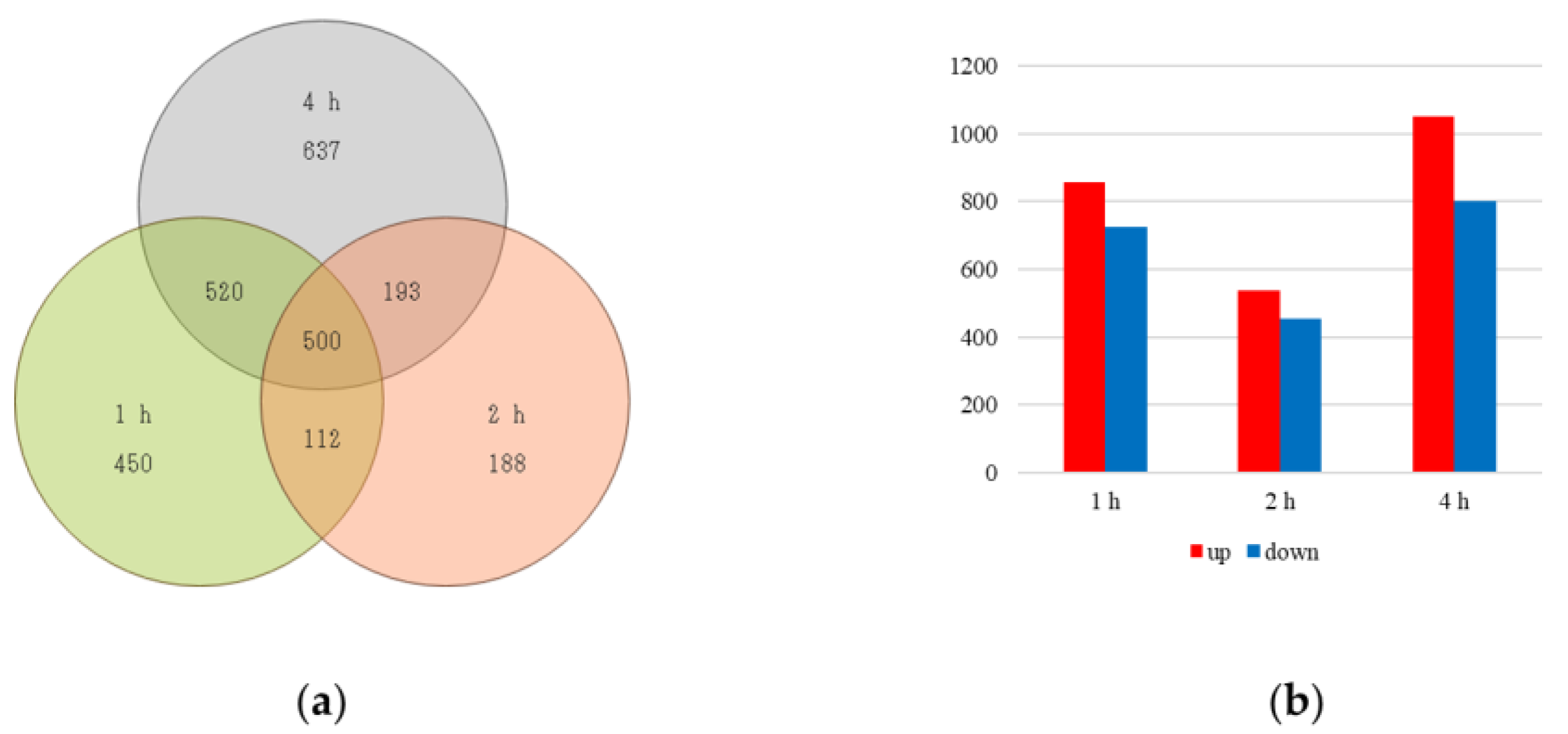
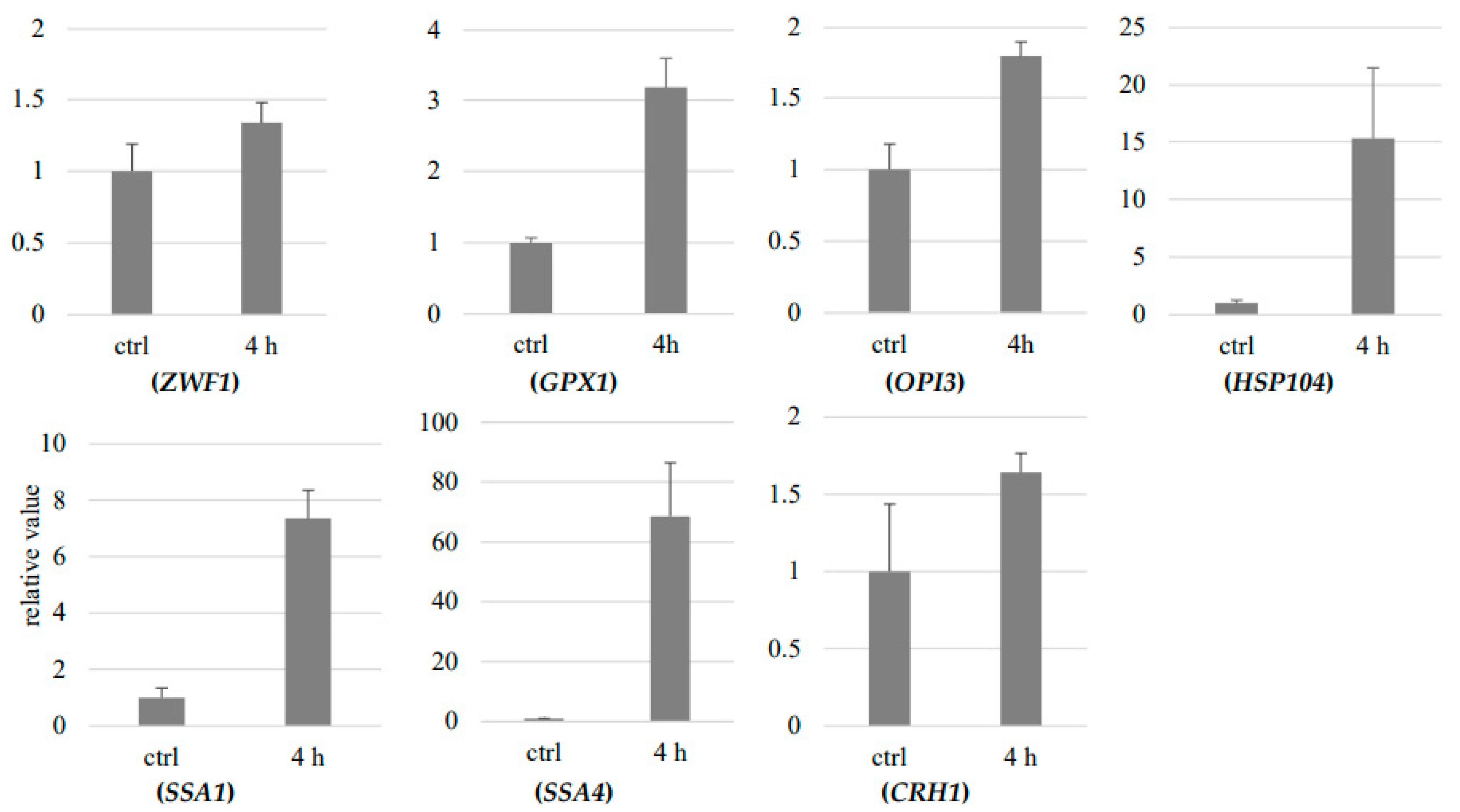
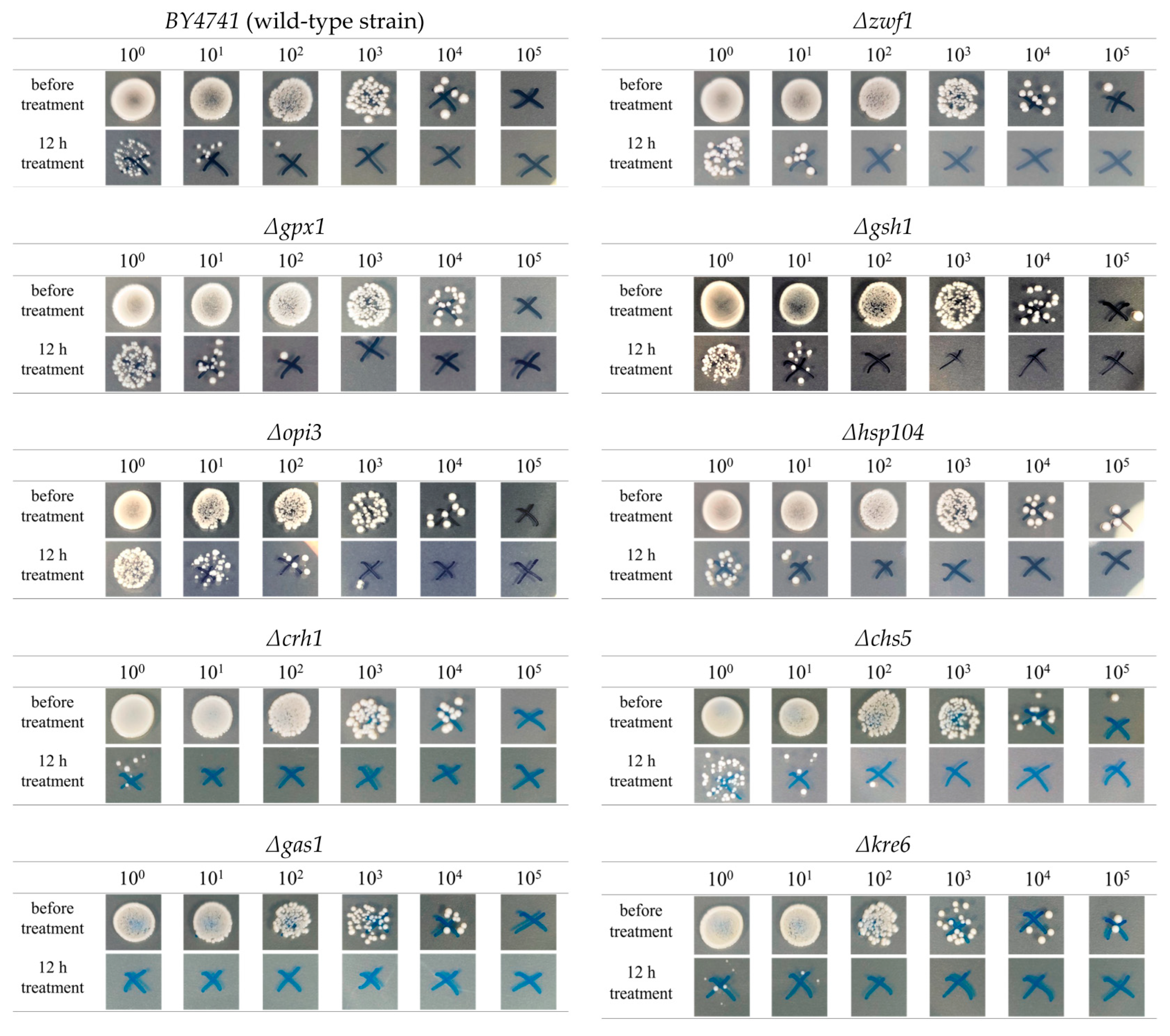
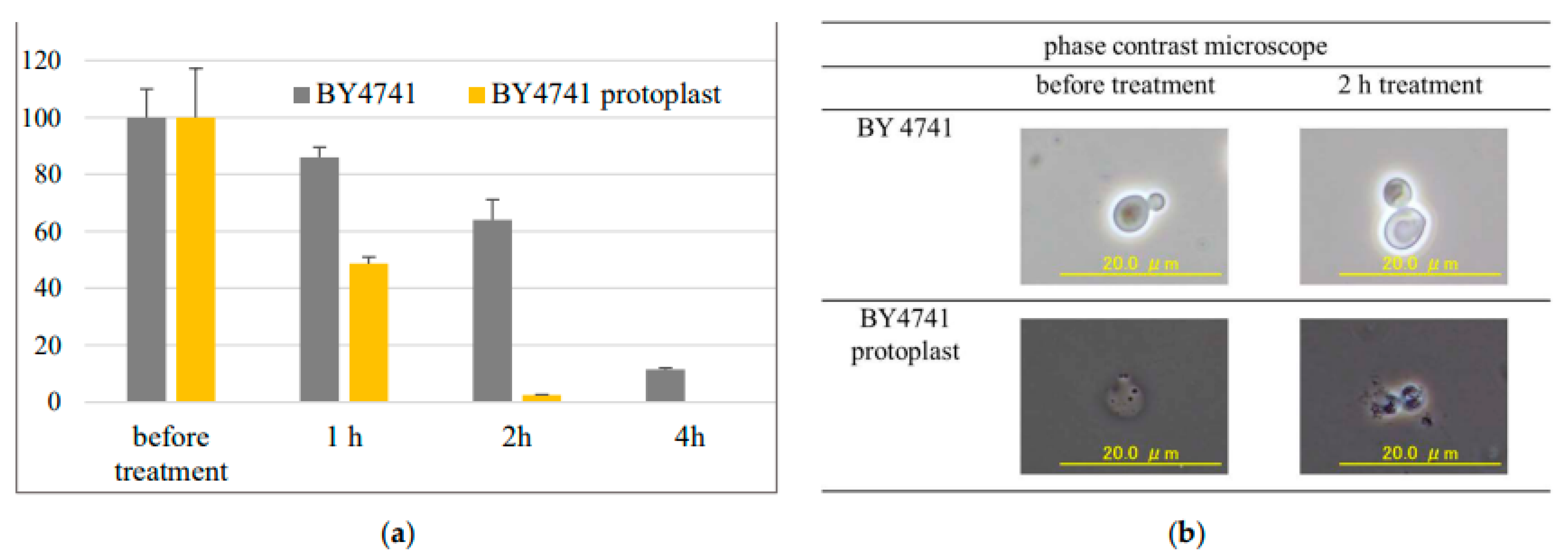
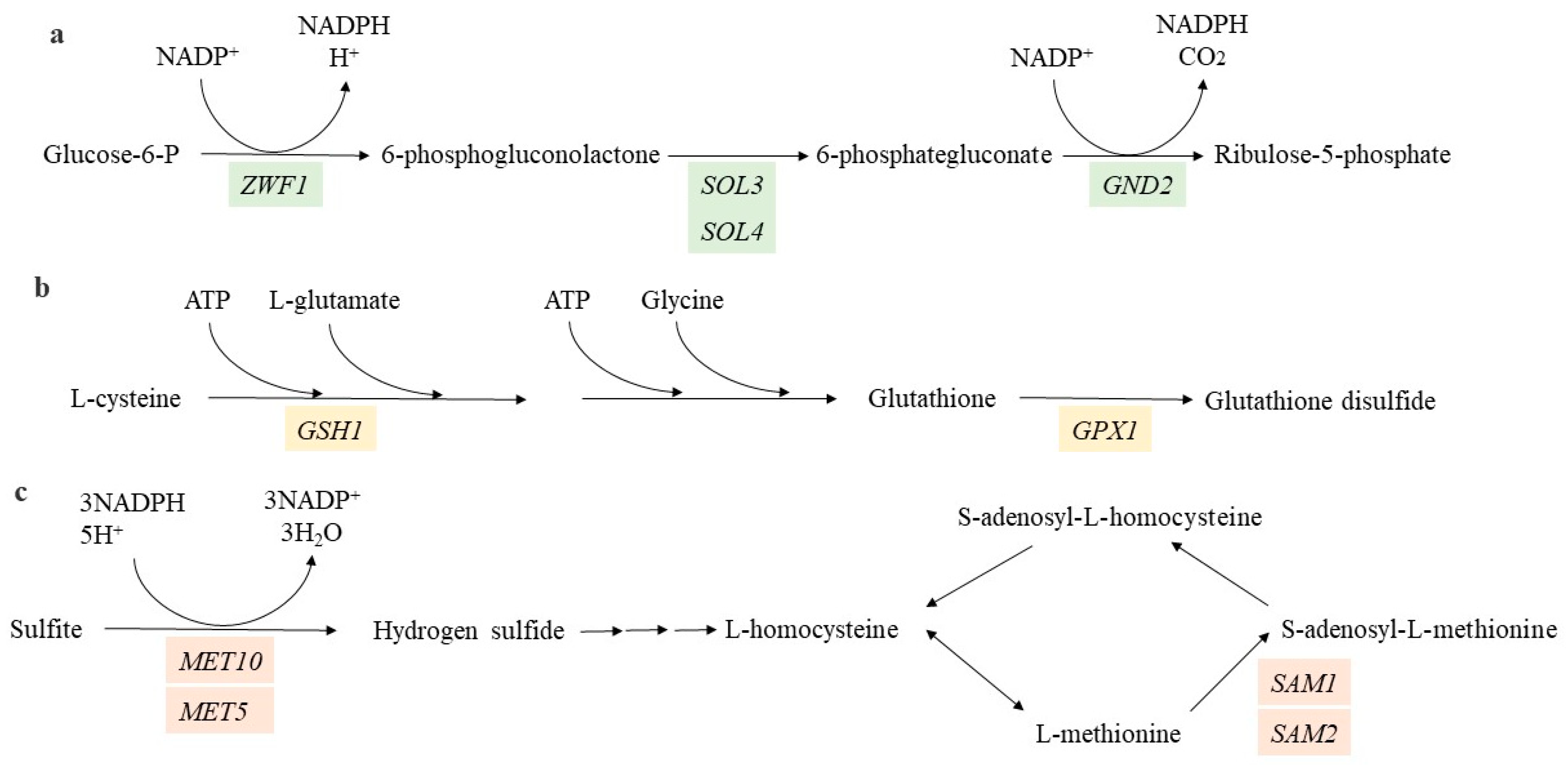

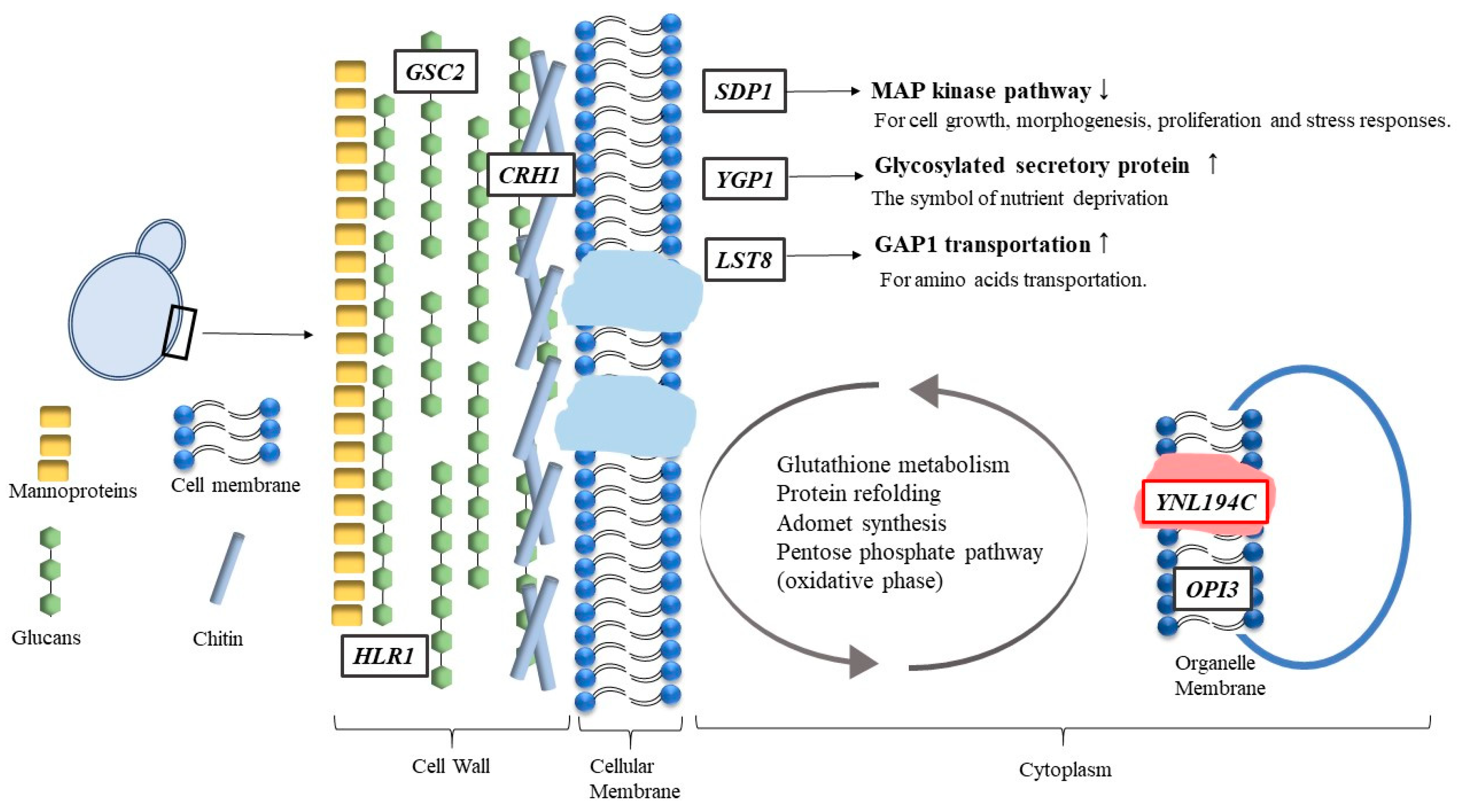
| Strain | Genotype |
|---|---|
| S. cerevisiae BY4741 | MATa his3Δ1 leu2 Δ0 met15Δ0 ura3Δ0 |
| S. cerevisiae BY4741 Δzwf1 | MATa his3Δ1 leu2 Δ0 met15Δ0 ura3Δ0 YNL241C::KanMX |
| S. cerevisiae BY4741 Δopi3 | MATa his3Δ1 leu2 Δ0 met15Δ0 ura3Δ0 YJR073C::KanMX |
| S. cerevisiae BY4741 Δgpx1 | MATa his3Δ1 leu2Δ0 met15Δ0 ura3Δ0 YKL026C::KanMX |
| S. cerevisiae BY4741 Δgsh1 | MATa his3Δ1 leu2 Δ0 met15Δ0 ura3Δ0 YJL101C::KanMX |
| S. cerevisiae BY4741 Δhsp104 | MATa his3Δ1 leu2Δ0 met15Δ0 ura3Δ0 YLL026W::KanMX |
| S. cerevisiae BY4741 Δcrh1 | MATa his3Δ1 leu2 Δ0 met15Δ0 ura3Δ0 YGR189C::KanMX |
| S. cerevisiae BY4741 Δchs5 | MATa his3Δ1 leu2 Δ0 met15Δ0 ura3Δ0 YLR330W::KanMX |
| S. cerevisiae BY4741 Δgas1 | MATa his3Δ1 leu2 Δ0 met15Δ0 ura3Δ0 YMR307W::KanMX |
| S. cerevisiae BY4741 Δkre6 | MATa his3Δ1 leu2 Δ0 met15Δ0 ura3Δ0 YPR159W::KanMX |
| Gene | Forward Primer | Reverse Primer | Product Size |
|---|---|---|---|
| ACT1 | ACATCGTTATGTCCGGTGGT | CCACCAATCCAGACGGAGTA | 142 bp |
| HSP104 | TGCTACCGCCGCTGATTTAA | GGATCATGGAGTTGGCACCA | 116 bp |
| SSA1 | TCTCCTCCATGGTCTTGGGT | AACCAGCAATGGTACCAGCA | 144 bp |
| SSA4 | ATTGCGTATGGGCTGGACAA | GTGTCACCAGCAGTAGCCTT | 137 bp |
| GPX1 | GGCAAAAGCAAGATCCCGTC | ACCACCTTCCCATTTCGGTC | 118 bp |
| CRH1 | GGCTGCCGAAAGTACTGCTA | CCGGCGTACAACCTGTAGTT | 92 bp |
| ZWF1 | TCGCATCGGGTGTCTTCAAA | AGCATTTGACAGACCAGGGG | 113 bp |
| OPI3 | CATTGCGTGAACAGCCTACG | GTCACCCAAGTACGTCCCTG | 140 bp |
| Sample | Raw Reads | Clean Reads | Raw Base (G) | Clean Base (G) | Q20 (%) | Q30 (%) | Mapping Rate (%) |
|---|---|---|---|---|---|---|---|
| c_1 | 16555668 | 16104561 | 5.0 | 4.8 | 97.84 | 93.63 | 97.63 |
| c_2 | 20000002 | 19561112 | 6.0 | 5.9 | 97.81 | 93.53 | 97.84 |
| t_1h | 15087780 | 14741627 | 4.5 | 4.4 | 97.86 | 93.65 | 97.37 |
| t_2h | 12503099 | 11982433 | 3.8 | 3.6 | 97.94 | 93.88 | 97.36 |
| t_4h | 17587792 | 17204215 | 5.3 | 5.2 | 97.85 | 93.63 | 97.55 |
| Gene Name | 1 h | 2 h | 4 h | Description |
|---|---|---|---|---|
| Pentose phosphate pathway, oxidative phase | ||||
| ZWF1 | 0.86 | 0.68 | 1.49 | Glucose-6-phosphate dehydrogenase (G6PD) |
| GND2 | 2.03 | 4.22 | 7.82 | 6-phosphogluconate dehydrogenase (decarboxylating) |
| SOL3 | 3.83 | 2.95 | 2.34 | 6-phosphogluconolactonase |
| SOL4 | 5.79 | 2.08 | 6.22 | 6-phosphogluconolactonase |
| Cell wall organization or biogenesis | ||||
| CRH1 | 0.64 | 0.80 | 1.50 | Chitin transglycosylase |
| GSC2 | 9.59 | 5.84 | 13.8 | Catalytic subunit of 1,3-beta-glucan synthase alternate catalytic subunit |
| ECM8 | 2.19 | 2.28 | 4.12 | Non-essential protein of unknown function |
| HLR1 | 2.04 | 2.21 | 2.95 | Protein involved in regulation of cell wall composition and integrity and response to osmotic stress |
| LDS2 | 5.84 | 2.14 | 8.82 | Protein of unknown function |
| SDP1 | 2.26 | 3.31 | 6.27 | Stress-inducible dual-specificity MAP kinase phosphatase |
| YMR084W | 7.11 | 4.47 | 11.0 | Putative protein of unknown function |
| YMR085W | 5.38 | 3.59 | 7.83 | Putative protein of unknown function |
| YNL194C | 7.64 | 4.22 | 14.1 | Integral membrane protein required for sporulation and plasma membrane sphingolipid content |
| YGP1 | 2.27 | 2.02 | 3.19 | Cell-wall-related secretory glycoprotein |
| LST8 | 10.62 | 4.77 | 35.4 | Protein required for the transport of amino acid permease Gap1p from the Golgi to the cell surface; component of the TOR signaling pathway |
| Glutathione metabolism | ||||
| GPX1 | 7.48 | 4.62 | 8.36 | Phospholipid hydroperoxide glutathione peroxidase |
| GSH1 | 3.01 | 2.28 | 3.29 | Gamma glutamylcysteine synthetase catalyzes the first step in glutathione (GSH) biosynthesis |
| Protein refolding | ||||
| HSP104 | 9.62 | 1.93 | 14.1 | Heat shock protein that cooperates with Ydj1p (Hsp40) and Ssa1p (Hsp70) to refold and reactivate previously denatured, aggregated proteins |
| SSA1 | 4.59 | 2.08 | 6.19 | ATPase involved in protein folding and nuclear localization signal (NLS)-directed nuclear transport |
| SSA4 | 61.9 | 9.64 | 83.2 | Heat shock protein that is highly induced upon stress |
| HSP82 | 11.4 | 2.33 | 17.6 | Hsp90 chaperone required for pheromone signaling and negative regulation of Hsf1p |
| SSE2 | 8.30 | 2.13 | 10.4 | Member of the heat shock protein 70 (HSP70) family |
| CPR6 | 5.82 | 2.26 | 9.13 | Peptidyl-prolyl cis–trans isomerase (cyclophilin) |
| Phosphatidylcholine biosynthesis | ||||
| OPI3 | 2.35 | 2.64 | 2.30 | Phospholipid methyltransferase (methylene-fatty-acyl-phospholipid synthase) |
| AdoMet synthesis | ||||
| Met5 | 1.77 | 2.43 | 2.04 | Sulfite reductase beta subunit, involved in amino acid biosynthesis |
| Met10 | 2.24 | 2.31 | 2.26 | Subunit alpha of assimilatory sulfite reductase |
| SAM1 | 4.87 | 2.83 | 3.20 | S-adenosylmethionine synthetase |
| SAM2 | 8.80 | 8.23 | 6.13 | S-adenosylmethionine synthetase |
Publisher’s Note: MDPI stays neutral with regard to jurisdictional claims in published maps and institutional affiliations. |
© 2022 by the authors. Licensee MDPI, Basel, Switzerland. This article is an open access article distributed under the terms and conditions of the Creative Commons Attribution (CC BY) license (https://creativecommons.org/licenses/by/4.0/).
Share and Cite
Yu, T.; Takahashi, U.; Iwahashi, H. Transcriptome Analysis of the Influence of High-Pressure Carbon Dioxide on Saccharomyces cerevisiae under Sub-Lethal Condition. J. Fungi 2022, 8, 1011. https://doi.org/10.3390/jof8101011
Yu T, Takahashi U, Iwahashi H. Transcriptome Analysis of the Influence of High-Pressure Carbon Dioxide on Saccharomyces cerevisiae under Sub-Lethal Condition. Journal of Fungi. 2022; 8(10):1011. https://doi.org/10.3390/jof8101011
Chicago/Turabian StyleYu, Tonghuan, Ukyo Takahashi, and Hitoshi Iwahashi. 2022. "Transcriptome Analysis of the Influence of High-Pressure Carbon Dioxide on Saccharomyces cerevisiae under Sub-Lethal Condition" Journal of Fungi 8, no. 10: 1011. https://doi.org/10.3390/jof8101011
APA StyleYu, T., Takahashi, U., & Iwahashi, H. (2022). Transcriptome Analysis of the Influence of High-Pressure Carbon Dioxide on Saccharomyces cerevisiae under Sub-Lethal Condition. Journal of Fungi, 8(10), 1011. https://doi.org/10.3390/jof8101011







